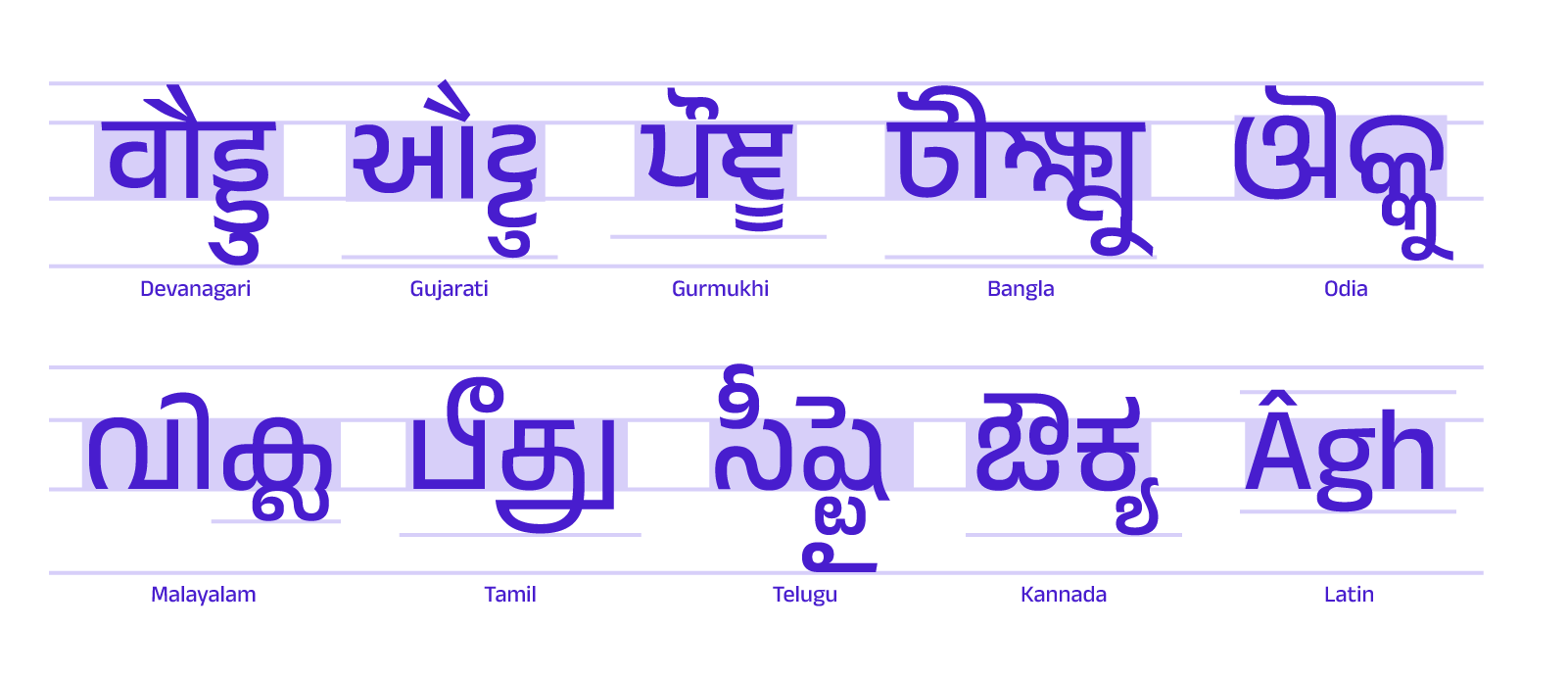
Anek, as the meaning of the word suggests, is an exercise in multiplicity — multiple scripts designed in multiple weights and widths by multiple designers. A well-informed, conscientious and refreshing interpretation of India’s letter traditions, this family offers a versatile system that can meet the demands of a wide range of applications.
Its expansive design space allows Anek to don multiple personalities. At its most condensed, capsular forms keep structures compact for that graphic texture. On the wide end of the spectrum, the extra legroom lets each letter yawn and stretch into their message. But it is in the boldest weights that Anek comes alive. Sharp terminals and tapered joineries sparkle amidst regimented forms, making this ideal for setting titillating headlines or that magnetic word-mark.
Anek comes in ten scripts: Bangla, Devanagari, Kannada, Latin, Gujarati, Gurmukhi, Malayalam, Odia, Tamil and Telugu. The shared aesthetics of this type-family are drawn from a collaboratively decided pool of visual features. At the same time, each script amalgamates influences from its own typographic culture as well as the perspectives of individual designers.
This project is designed, engineered and maintained by Ek Type; a collective of type designers based in Mumbai focused on designing contemporary Indian typefaces. Contributors of this project are: Maithili Shingre (Anek Malayalam, Anek Kannada), Yesha Goshar (Anek Latin, Anek Odia), Kailash Malviya (Anek Devanagari), Aadarsh Rajan (Anek Tamil), Sulekha Rajkumar (Anek Bangla), Vaishnavi Murthy (Anek Kannada), Omkar Bhoir (Anek Telugu), Mrunmayee Ghaisas (Anek Gujarati), Mahesh Sahu (Anek Odia), and Sarang Kulkarni (Anek Gurmukhi). Project management and design assistance by Noopur Datye, and Font engineering and design assistance by Girish Dalvi.
To contribute, see github.com/EkType/Anek

The Anek multi-script typeface for 9 Indian languages and Latin was made through a collaboration of 12 type designers working across 8 cities in India.
How did Ek Type win two type design awards (the TDC Certificate of Typographic Excellence and the D&AD Graphite Pencil) for their Anek multi-script typeface?
There were two key factors to their success:
Getting 12 people to collaborate while speaking in three languages (English, Hindi, and Marathi) and spread out in eight different Indian cities (Mumbai, Pune, Kalyan, Hinganghat, Baroda, Bengaluru, Bharampur, and Pali) is not an easy task.
Ek Type established a collaboration structure that fostered teamwork, while also giving designers the liberty to be creative.
The team consisted of Maithili Shingre, Yesha Goshar, Kailash Malviya, Aadarsh Rajan, Sulekha Rajkumar, Vaishnavi Murthy, Omkar Bhoir, Mrunmayee Ghaisas, Mahesh Sahu, Sarang Kulkarni, Noopur Datye, and Girish Dalvi.
Ten people focused on one script each, while the other two members worked on font engineering and project management. The designers focused on the script that was most familiar to them.
Via three- to four-hour weekly video calls, team members annotated drawings with emojis, arrows, text, and other marks in their video conference platform. In between calls, the team collaborated online. The team made design decisions based on majority or unanimous votes.
Before the pandemic, most of the team had worked together at the Ek Type studio in Mumbai. Remote work created some unforeseen benefits. “Everyone had the time to venture in different directions, not getting colored by what the others were doing,” said Noopur Datye, co-founder and type designer at Ek Type.
To learn more, read Multilingual scripts for multilingual India.